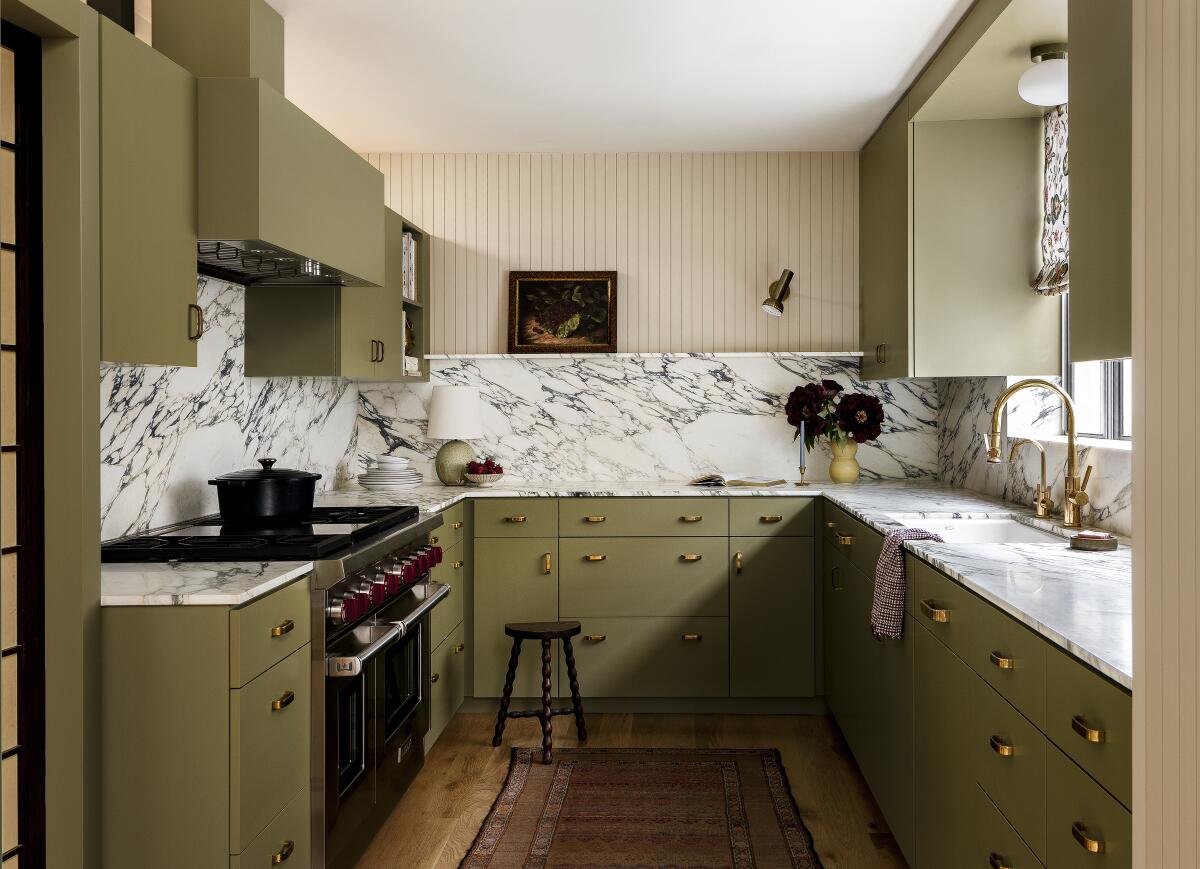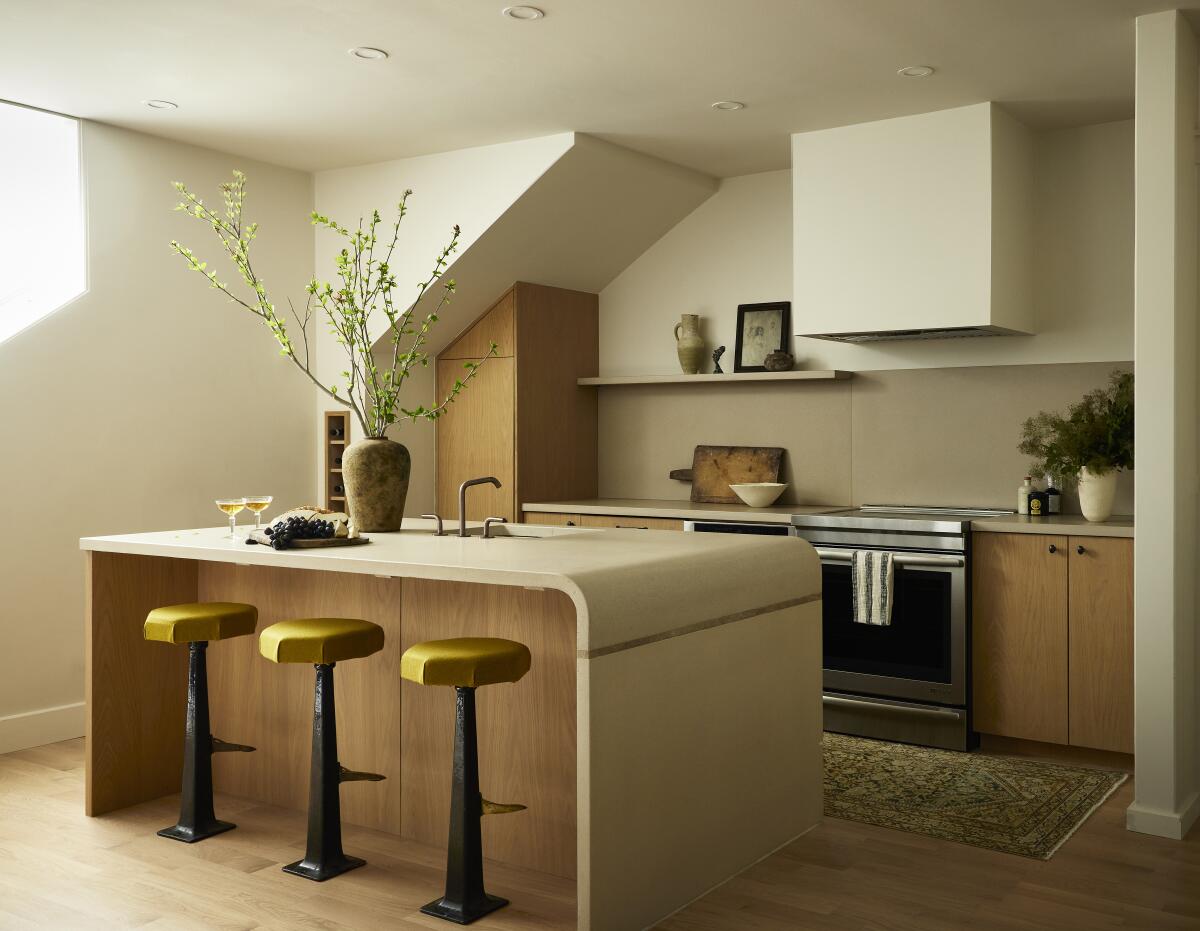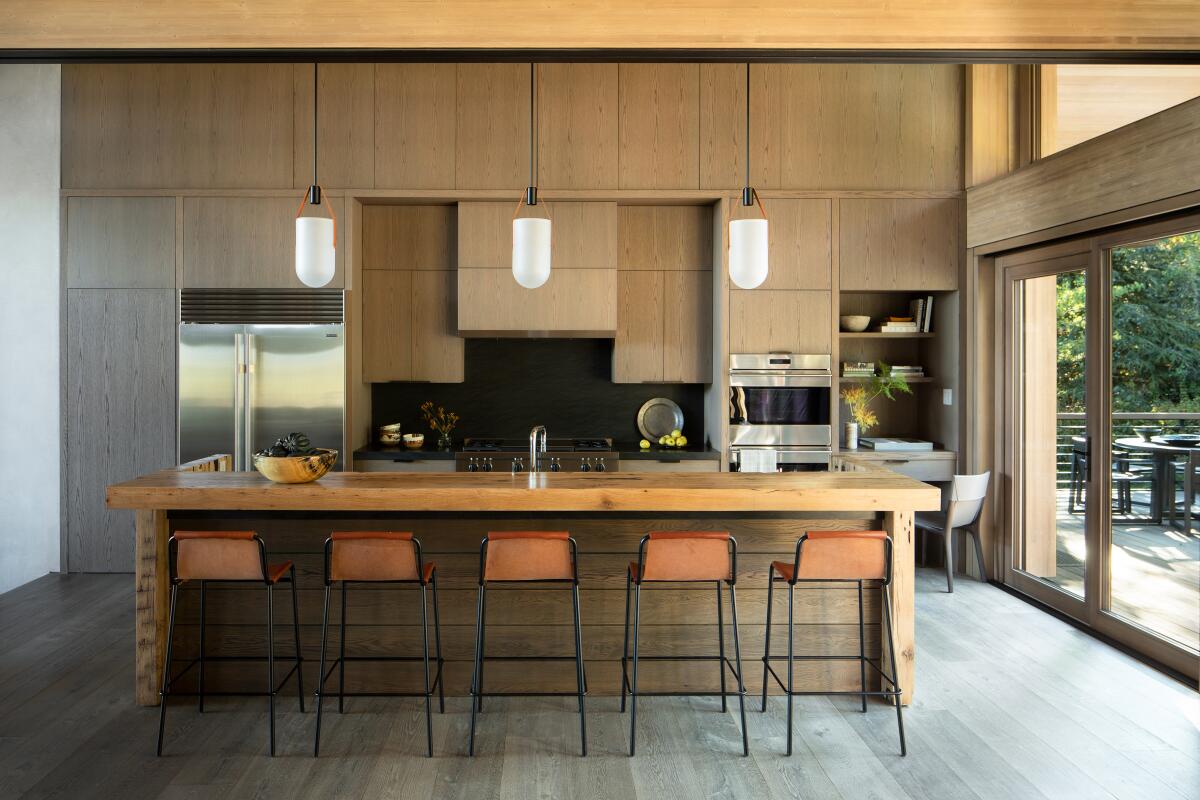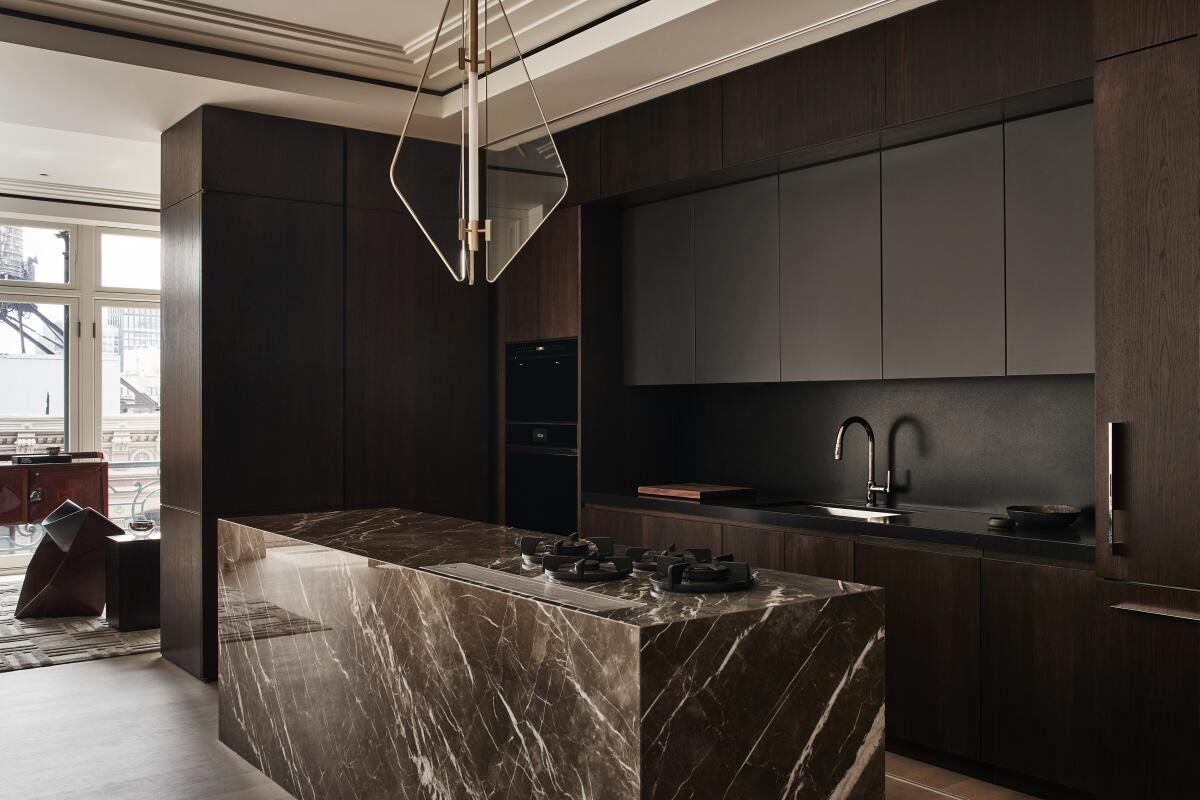When you’re renovating a kitchen, it’s easy to get swept up in choosing cabinets, counters and appliances. But there’s another element that matters just as much: lighting.
“The importance of lighting in a kitchen is twofold,” said Rush Jenkins, CEO of WRJ Design in Jackson, Wyo. “One is having sufficient light on surfaces to see what you’re doing. The other is decorative lighting, which can enhance a home in the same way that gorgeous jewelry enhances a beautiful outfit.”
And now that food preparation spaces double as gathering places, using lighting to set the mood is more important than ever, said Jenn Feldman, a Los Angeles-based interior designer.
“The kitchen isn’t just a place you go to cook,” Feldman said. “It’s livable space.”
She and other designers shared tips on how to light your kitchen.

Meghan Eisenberg, an interior designer, installed separate light fixtures above the sink and the primary food preparation area in her kitchen in Los Angeles. Lighting can dramatically affect the way a kitchen looks and how it is used.
(Haris Kenjar via The New York Times)
Create layers of light
Professional architects and designers rarely use a single fixture to blast a kitchen with light. Instead, they focus on creating layers of light with different types of fixtures used in different ways.
“I love to cook and bake, and when I’m working, I need it bright,” said Blair Moore, founder of Moore House Design, in Warren, R.I. But if she’s having friends over for cocktails and canapés, she wants something else.
“When I’m entertaining, I want to be sure there’s no overhead light on at all,” she said. “That’s when we use ambient or accent lighting instead.”
The best way to get that? Using sconces or similar fixtures.
Moore added, “I always like to have three layers of lighting”: general lighting, task lighting, and ambient or accent lighting. That makes it easy to illuminate the room in different ways.
Start with the most basic lighting
When you’re making a lighting plan, you should begin by choosing fixtures for general illumination: surface-mounted ceiling fixtures, linear track systems or recessed can-style lights.
Regardless of the type of fixture you choose, placement is key.

Recessed ceiling lights in a kitchen by Moore House Design. Designers interviewed for this story prefer smaller-aperture lights, 2 to 3 inches in diameter and flush with the ceiling.
(Jared Kuzia via The New York Times)
“People want these spaces to be well lit, but we really try to think about what we’re lighting,” said Matt Berman, a founding principal of the New York-based architecture firm Workshop/APD. That means focusing on counters, circulation paths and key functional areas like the sink and stove.
His firm usually aligns ceiling lights along runs of cabinetry, Berman said, rather than installing a grid of recessed fixtures that blanket the room in light.
All the designers interviewed for this story like ceiling fixtures to be so unobtrusive that they almost disappear. When they’re using recessed fixtures, they prefer smaller-aperture ceiling lights, with an opening of 2 or 3 inches, and trimless designs that are installed flush to the ceiling with a coat of drywall compound. Berman also likes recessed track systems that hold multiple lights within a single cut in the ceiling.
Add more light above work surfaces
Even with most of the room illuminated, it’s helpful to bring focused task lighting to counters where you’ll be chopping vegetables, carving meat and grating cheese. If you don’t have upper cabinets, one way to do this is to install simple sconces or pendants that project light down to the counters.
Feldman added brass sconces above the counters of her own kitchen. Moore has used articulating scissor-arm sconces that can extend and swivel to provide light wherever it’s needed.
If you have upper cabinets, a better approach is usually to add under-counter LED strips. Concealed with a valance or recessed into the cabinets, they can illuminate the entire length of a counter while remaining hidden from view.

Allied Maker pendants hover over a dining nook in a kitchen by WRJ Design, inspired by the blackened metal and tan leather of the counter stools. An essential principle of lighting design is to focus on functional areas of the room.
(Tuck Fauntleroy via The New York Times)
“It’s very helpful to have under-cabinet lighting,” said Meghan Eisenberg, an interior designer in Los Angeles who chose a stylish sconce to illuminate counters in her own kitchen, but now wishes she had added under-cabinet lighting as well.
“We didn’t do it, and I lived to regret it,” she said. “Because it’s really nice to have under-cabinet lighting when you’re cleaning and the upper cabinets are casting shadows.”
If you’re worried that some cabinet interiors will be too dark, you can also add LED strips inside the cabinets that will turn on automatically when doors and drawers are opened.
Make a statement with decorative fixtures
Don’t ignore the opportunity to make a statement in the kitchen with decorative fixtures, much as you would in a dining room. Often, this is a chandelier or a series of pendant lamps above an island.
Jenkins, of WRJ Design, has used brass-and-bubbled-glass chandeliers by Lindsey Adelman, leather-and-frosted-glass pendants from Allied Maker and linear fixtures of smoky blown glass by Gabriel Scott to dramatic effect.
“You have this wonderful interior,” he said, “and then when you bring in beautiful lighting, it bumps it up and creates a focal point.”
But it’s important to consider what else is around that fixture, he added. If the showstopping fixture will interrupt sightlines to a window with a view, Jenkins will search out a fixture with clear-glass diffusers. Otherwise, he might opt for a fixture with opaque or translucent shades that pick up on other materials used in the kitchen cabinetry and furniture.
It’s also wise to study nearby light fixtures, if the kitchen is open to other living spaces, Eisenberg said. When the kitchen island is next to a dining table, she will hang a single statement-making fixture over just one of those areas.
“I always pick and choose where I want people to focus,” she said. “I don’t want to have one pendant hanging over the dining table and then a different one in the kitchen.”
Plan the controls
To take full advantage of so many layers of lighting, you’ll need to be able to control them. At the very least, different types of lighting — general, task and decorative — should be split up on separate switches. Using dimmers is even better.
The next step up would be a home-automation system with smart dimmers, allowing you to set scenes for various times of day and uses. “That way you can set an evening scene where the lights are dimmer and a morning scene where the lights are nice and bright,” Berman said.
It’s also important to know the color temperature of the various lights you plan to use. While LEDs with a color temperature of 2,700 Kelvin are similar to incandescent lightbulbs, Berman noted, in the kitchen “we’ll bump it up to 3,000 Kelvin, which is a little brighter and whiter.”
That color temperature is great when you’re making breakfast but may not be ideal if you want warmer, dimmer light for cocktail hour. One solution is to search out fixtures that use dim-to-warm LEDs, Berman said, gradually shifting to warmer color temperatures as you dim them down.

Concealed lighting, including under-cabinet LEDs, allows a single decorative pendant to be the center of attention in a kitchen designed by Workshop/APD.
(Adrian Gaut via The New York Times)
Whether you use dim-to-warm lights or not, all of the fixtures in your kitchen should be a similar color temperature.
“There’s nothing more annoying that having beautiful warm light” in one area, Jenkins said, “and then bright-white, fluorescent-like light beside it.”
Embrace plug-in options
While most kitchen lighting is built in, it’s possible to bring a few extra lumens to dark corners, and an extra dash of style, with plug-in lamps. Eisenberg, Feldman and Moore have all used table lamps in kitchens.
“I always love a table lamp on a counter,” Moore said. Especially now that kitchens serve as living spaces, she added, “I just love that it feels like furniture.”
Feldman likes the look so much she designed one kitchen with a switched outlet above a wall shelf, so she could plug in a table lamp and have it wired to the same wall dimmer as the sconces.
“Lamps are a really fun and beautiful way to play with dressing the space,” Feldman said.
In the end, illuminating a kitchen “is really about the sum of all the parts,” she added. “Which is not dissimilar to how you cook in a kitchen with multiple ingredients.”
McKeough is a freelance writer. This article appeared in The New York Times.
